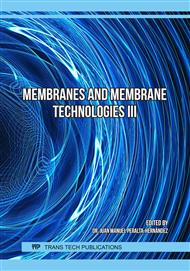[1]
A.S. Shaplov, D.O. Ponkratov, P.S. Vlasov, E.I. Lozinskaya, L.I. Komarova, I.A. Malyshkina, F. Vidal, G.T.M. Nguyen, M. Armand, C. Wandrey, Y.S. Vygodskii, Synthesis and properties of polymeric analogs of ionic liquids, Polym. Sci. - Ser. B. 55 (2013) 122–138. https://doi.org/10.1134/S1560090413030044.
DOI: 10.1134/s1560090413030044
Google Scholar
[2]
J. Yoon, H.-J. Lee, C.M. Stafford, Thermoplastic Elastomers Based on Ionic Liquid and Poly(vinyl alcohol), Macromolecules. 44 (2011). https://doi.org/10.1021/ma102682k.
DOI: 10.1021/ma102682k
Google Scholar
[3]
Y. Yang, H. Gao, F. Lu, L. Zheng, Preparation and characterization of composite membranes with Brønsted acidic ionic liquid, Colloid Polym. Sci. 292 (2014) 2831–2839. https://doi.org/10.1007/s00396-014-3324-7.
DOI: 10.1007/s00396-014-3324-7
Google Scholar
[4]
C.W. Liew, S. Ramesh, A.K. Arof, Good prospect of ionic liquid based-poly(vinyl alcohol) polymer electrolytes for supercapacitors with excellent electrical, electrochemical and thermal properties, in: Int. J. Hydrogen Energy, Pergamon, 2014: p.2953–2963. https://doi.org/10.1016/j.ijhydene.2013.06.061.
DOI: 10.1016/j.ijhydene.2013.06.061
Google Scholar
[5]
E. Rynkowska, K. Fatyeyeva, W. Kujawski, Application of polymer-based membranes containing ionic liquids in membrane separation processes: A critical review, Rev. Chem. Eng. 34 (2018) 341–363. https://doi.org/10.1515/revce-2016-0054.
DOI: 10.1515/revce-2016-0054
Google Scholar
[6]
C.W. Liew, S. Ramesh, A.K. Arof, A novel approach on ionic liquid-based poly(vinyl alcohol) proton conductive polymer electrolytes for fuel cell applications, in: Int. J. Hydrogen Energy, Pergamon, 2014: p.2917–2928. https://doi.org/10.1016/j.ijhydene.2013.07.092.
DOI: 10.1016/j.ijhydene.2013.07.092
Google Scholar
[7]
A.I. Akhmetshina, N.R. Yanbikov, A.A. Atlaskin, M.M. Trubyanov, A. Mechergui, K. V. Otvagina, E.N. Razov, A.E. Mochalova, I. V. Vorotyntsev, Acidic gases separation from gas mixtures on the supported ionic liquid membranes providing the facilitated and solution-diffusion transport mechanisms, Membranes (Basel). 9 (2019) 1–14. https://doi.org/10.3390/membranes9010009.
DOI: 10.3390/membranes9010009
Google Scholar
[8]
I.M. Davletbaeva, G.R. Nurgaliyeva, A.I. Akhmetshina, R.S. Davletbaev, A.A. Atlaskin, T.S. Sazanova, S. V. Efimov, V. V. Klochkov, I. V. Vorotyntsev, Porous polyurethanes based on hyperbranched amino ethers of boric acid, RSC Adv. 6 (2016) 111109–111119. https://doi.org/10.1039/C6RA21638B.
DOI: 10.1039/c6ra21638b
Google Scholar
[9]
P. Izák, M. Köckerling, U. Kragl, Stability and selectivity of a multiphase membrane, consisting of dimethylpolysiloxane on an ionic liquid, used in the separation of solutes from aqueous mixtures by pervaporation, Green Chem. 8 (2006) 947–94. https://doi.org/10.1039/b608114b.
DOI: 10.1039/b608114b
Google Scholar
[10]
A. Samadi, R.K. Kemmerlin, S.M. Husson, Polymerized ionic liquid sorbents for CO2 separation, Energy and Fuels. 24 (2010) 5797–5804. https://doi.org/10.1021/ef101027s.
DOI: 10.1021/ef101027s
Google Scholar
[11]
M. Díaz, A. Ortiz, I. Ortiz, Progress in the use of ionic liquids as electrolyte membranes in fuel cells, J. Memb. Sci. 469 (2014) 379–396. https://doi.org/10.1016/j.memsci.2014.06.033.
DOI: 10.1016/j.memsci.2014.06.033
Google Scholar
[12]
C.W. Liew, K.H. Arifin, J. Kawamura, Y. Iwai, S. Ramesh, A.K. Arof, Electrical and structural studies of ionic liquid-based poly(vinyl alcohol) proton conductors, J. Non. Cryst. Solids. 425 (2015) 163–172. https://doi.org/10.1016/j.jnoncrysol.2015.06.008.
DOI: 10.1016/j.jnoncrysol.2015.06.008
Google Scholar
[13]
Y. Gu, T.P. Lodge, Synthesis and gas separation performance of triblock copolymer ion gels with a polymerized ionic liquid mid-block, Macromolecules. 44 (2011) 1732–1736. https://doi.org/10.1021/ma2001838.
DOI: 10.1021/ma2001838
Google Scholar
[14]
P. Bernardo, J.C. Jansen, F. Bazzarelli, F. Tasselli, A. Fuoco, K. Friess, P. Izák, V. Jarmarová, M. Kačírková, G. Clarizia, Gas transport properties of Pebax®/room temperature ionic liquid gel membranes, in: Sep. Purif. Technol., Elsevier, (2012) 73–82. https://doi.org/10.1016/j.seppur.2012.02.041.
DOI: 10.1016/j.seppur.2012.02.041
Google Scholar
[15]
K. Friess, J.C. Jansen, F. Bazzarelli, P. Izák, V. Jarmarová, M. Kačírková, J. Schauer, G. Clarizia, P. Bernardo, High ionic liquid content polymeric gel membranes: Correlation of membrane structure with gas and vapour transport properties, J. Memb. Sci. 415–416 (2012) 801–809. https://doi.org/10.1016/j.memsci.2012.05.072.
DOI: 10.1016/j.memsci.2012.05.072
Google Scholar
[16]
T. Yasuda, S.I. Nakamura, Y. Honda, K. Kinugawa, S.Y. Lee, M. Watanabe, Effects of polymer structure on properties of sulfonated polyimide/protic ionic liquid composite membranes for nonhumidified fuel cell applications, ACS Appl. Mater. Interfaces. 4 (2012) 1783–1790. https://doi.org/10.1021/am300031k.
DOI: 10.1021/am300031k
Google Scholar
[17]
H.R. Cascon, S.K. Choudhari, 1-Butanol pervaporation performance and intrinsic stability of phosphonium and ammonium ionic liquid-based supported liquid membranes, J. Memb. Sci. 429 (2013) 214–224. https://doi.org/10.1016/j.memsci.2012.11.028.
DOI: 10.1016/j.memsci.2012.11.028
Google Scholar
[18]
J.C. Jansen, G. Clarizia, P. Bernardo, F. Bazzarelli, K. Friess, A. Randová, J. Schauer, D. Kubicka, M. Kacirková, P. Izak, Gas transport properties and pervaporation performance of fluoropolymer gel membranes based on pure and mixed ionic liquids, Sep. Purif. Technol. 109 (2013) 87–97. https://doi.org/10.1016/j.seppur.2013.02.034.
DOI: 10.1016/j.seppur.2013.02.034
Google Scholar
[19]
M. Díaz, A. Ortiz, M. Vilas, E. Tojo, I. Ortiz, Performance of PEMFC with new polyvinyl-ionic liquids based membranes as electrolytes, in: Int. J. Hydrogen Energy, Pergamon, 2014: p.3970–3977. https://doi.org/10.1016/j.ijhydene.2013.04.155.
DOI: 10.1016/j.ijhydene.2013.04.155
Google Scholar
[20]
M. Díaz, A. Ortiz, M. Isik, D. Mecerreyes, I. Ortiz, Highly conductive electrolytes based on poly([HSO3-BVIm][TfO])/[HSO3-BMIm][TfO] mixtures for fuel cell applications, Int. J. Hydrogen Energy. 40 (2014) 11294–11302. https://doi.org/10.1016/j.ijhydene.2015.03.109.
DOI: 10.1016/j.ijhydene.2015.03.109
Google Scholar
[21]
J.E. Bara, S. Lessmann, C.J. Gabriel, E.S. Hatakeyama, R.D. Noble, D.L. Gin, Synthesis and performance of polymerizable room-temperature ionic liquids as gas separation membranes, Ind. Eng. Chem. Res. 46 (2007) 5397–5404. https://doi.org/10.1021/ie0704492.
DOI: 10.1021/ie0704492
Google Scholar
[22]
M.G. Cowan, D.L. Gin, R.D. Noble, Poly(ionic liquid)/Ionic Liquid Ion-Gels with High free, Ionic Liquid Content: Platform Membrane Materials for CO2/Light Gas Separations, Acc. Chem. Res. 49 (2016) 724–732. https://doi.org/10.1021/acs.accounts.5b00547.
DOI: 10.1021/acs.accounts.5b00547
Google Scholar
[23]
O.V. Bashkov, A.A. Popkova, G.A. Gadoev, T.I. Bashkova, D.B. Solovev, Construction of a Generalized Fatigue Diagram of Metallic Materials, Materials Science Forum, Vol. 945, (2019) 563-568. [Online] Available: https://doi.org/10.4028/www.scientific.net/MSF.945.563.
DOI: 10.4028/www.scientific.net/msf.945.563
Google Scholar



